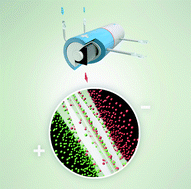Clean energy generation using capacitive electrodes in reverse electrodialysis
Abstract
Capacitive reverse

* Corresponding authors
a Wetsus, Centre of Excellence for Sustainable Water Technology, P.O. Box 1113, 8900 CC Leeuwarden, The Netherlands
b
Membrane Science and Technology, University of Twente, P.O. Box 217, 7500 AE Enschede, The Netherlands
E-mail:
d.c.nijmeijer@utwente.nl
Tel: +31 53 489 4185
c Sub-department of Environmental Technology, Wageningen University, Bornse Weilanden 9, Technotron building 118, 6708 WG, Wageningen, The Netherlands
Capacitive reverse

 Please wait while we load your content...
Something went wrong. Try again?
Please wait while we load your content...
Something went wrong. Try again?
D. A. Vermaas, S. Bajracharya, B. B. Sales, M. Saakes, B. Hamelers and K. Nijmeijer, Energy Environ. Sci., 2013, 6, 643 DOI: 10.1039/C2EE23562E
To request permission to reproduce material from this article, please go to the Copyright Clearance Center request page.
If you are an author contributing to an RSC publication, you do not need to request permission provided correct acknowledgement is given.
If you are the author of this article, you do not need to request permission to reproduce figures and diagrams provided correct acknowledgement is given. If you want to reproduce the whole article in a third-party publication (excluding your thesis/dissertation for which permission is not required) please go to the Copyright Clearance Center request page.
Read more about how to correctly acknowledge RSC content.
 Fetching data from CrossRef.
Fetching data from CrossRef.
This may take some time to load.
Loading related content
